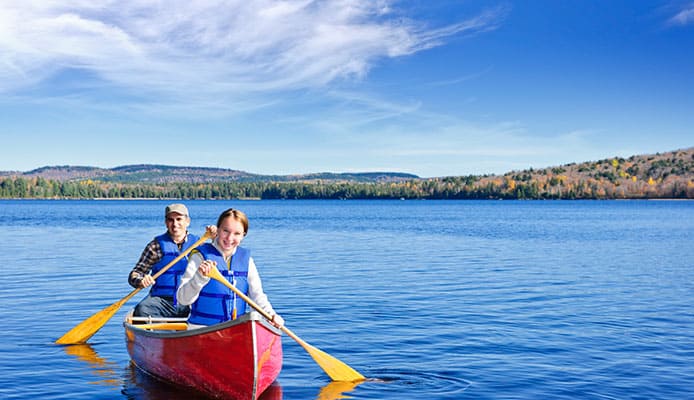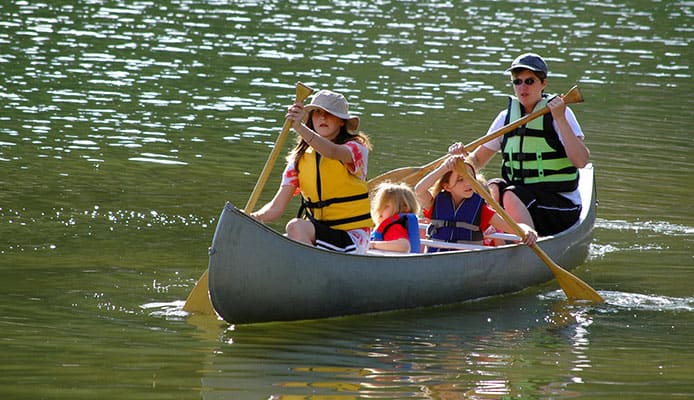
There are plenty of ways to paddle a canoe and the more you advance in your canoeing, the more canoeing strokes that you are going to learn.
When you imagine a man or a woman on a canoe, you will almost always think of the forward stroke. It is basic, simple to perform, and gets the canoe moving forward.
However, if you want to gain control of your canoe propulsion and get it exactly where you want it to go, you are going to want to learn J-stroke canoeing.
Why is it called the j-stroke you might wonder? Well, someone somewhere decided that the motion of the paddle represented the letter J. However, he was wrong because it doesn’t but the name held on through the years.
Always ensure that you wear a life jacket before getting into the canoe. After many years of nomenclature, and error put aside, we are going to learn how to correctly do the canoe j-stroke. And this is how.
How the j-stroke works
Before we can learn to perform the canoe j stroke, it’s important to first go through a simple beginner’s guide to canoeing. let’s first understand the canoe paddle. It has a handle, a shaft, a shoulder where the blade begins, and of course the blade itself.
Related Post: Fun Canoe Games And Activities
The blade has the front side of the power face which you use to power the canoe and the backside.
The function of J stroke canoeing is to correct the canoe from its tendency to turn when paddling. Of course, you will need to learn how to do a proper forward stroke to reduce the need for correction. It will involve you bringing the paddle as close to the canoe as possible and making paddling alongside the cross-section of the canoe.
The canoe j stroke begins with you performing the usual forward stroke. However, instead of ending the forward stroke as you normally would, right when the shaft of the paddle is beside your knee, you will start a pry.
To perform the pry, you will need to twist the hand you are using to control the paddle such that the thumb points towards the canoe bow. All the time, you will be allowing the shaft to turn by moving it with the hand at the handle and loosening the grip on the shaft.
Now the power side of the blade will be away from you. It is time to pull the hand you are using to control the paddle inwards over your knee. Ensure you are also bracing the paddle right against the gunwale of the canoe.
The motion makes it possible to pry the blade of the paddle away from the canoe and off the gunwale. Now that you have made the necessary correction, continue with proper forward strokes.
It takes practice to perform the j stroke correctly. However, as you become more and more conversant with it, you will quickly learn that the j stroke canoeing blends perfectly from a forward stroke. When doing the j-stroke, try and make it as natural as possible to minimize splashing and noise.
This is wasted energy that would have been used to propel you forward. Ooh, and if you are canoeing in the sea and you feel like being seasick, you can stop seasickness with 3 easy tricks.
Tips for doing the j-stroke
Keep in mind that when practicing the j-stroke, you are going to get sore in your hands. This is all part of the learning process and it will go away with time.
As you become accustomed to the j-stroke, you will know just how much push you are going to give at the end of each stroke to move the canoe where you want it to go.
For the canoe to keep moving straight ensure that you rudder during the j-part of the stroke only as much as is necessary.
For the j-stroke to be effective, it needs to be performed while sitting at the rear of the canoe. This makes it possible to move the canoe in a straight line.
If there is another person sited in the front of the canoe, he or she should paddle opposite to the person at the back. The person at the front, however, should be using the forward stroke.
For maximum power, make use of the torso and upper body during rotation. This is where the energy should be coming from instead of just using your arms.
Once you have achieved the first j stroke, take the paddle from the water and repeat the whole process until the canoe is moving in the direction that you want it to. Always ensure that you are sited straight in the canoe and that you maintain a good grip on the canoe paddle.
How often you will use the j-stroke
As effective as the j-stroke is, you will not need to use it every time. Often the j-stroke is only needed every 2 to 3 times.
If there are two of you on the canoe, and the paddler at the front just happens to be stronger than you, then you might only need to use the canoe j stroke very few times.
Sometimes you may find yourself in rough seas and turbulent waters. In this case, the stronger paddler at the front should move to the back and vice versa. There is plenty of recreational kayaking and canoeing is great exercise.
Globo Surf Overview
Like every other canoeing stroke, you will need to take time to practice the j-stroke if you are going to be effective at it. Don’t let sore hands stop you from being an awesome canoeist. Soon you will be able to propel your canoe in a relatively straight line with as little effort as possible.
More Canoe Guides:
- How To DIY Canoe Outrigger
- How To Repair A Fiberglass Canoe?
- Kayak vs Canoe – What Are The Big Differences Between Them?
- Canoe Seating Position: Where To Sit In A Canoe?
- Canoe Self-Rescue Technique: How To Get Into A Canoe From Water
Canoe Reviews:
Single Canoe Product Reviews:


